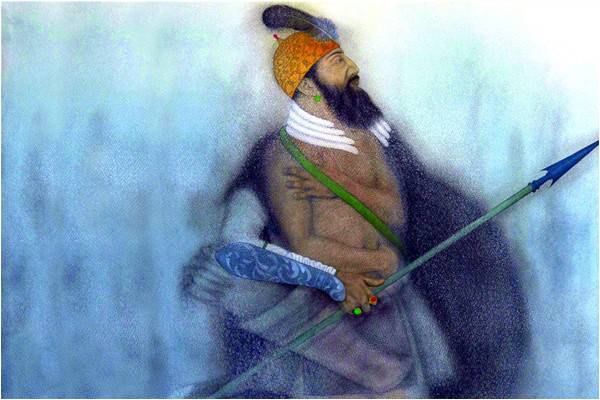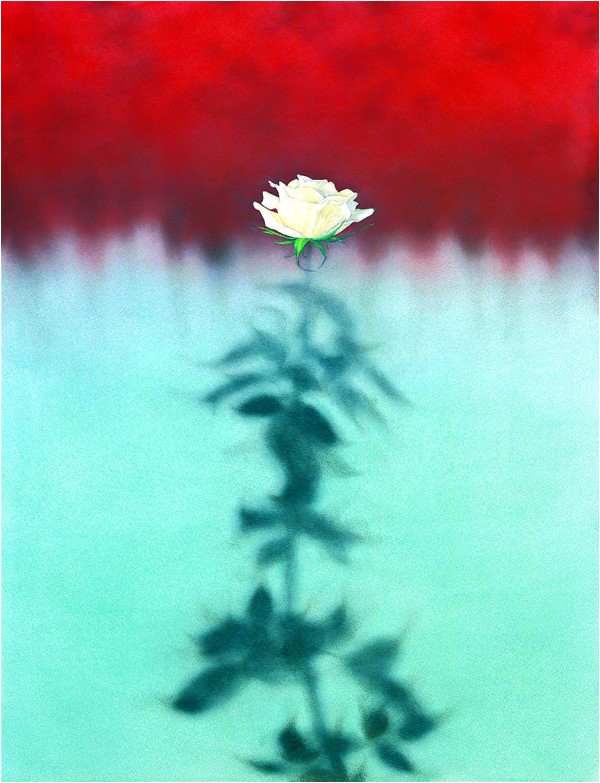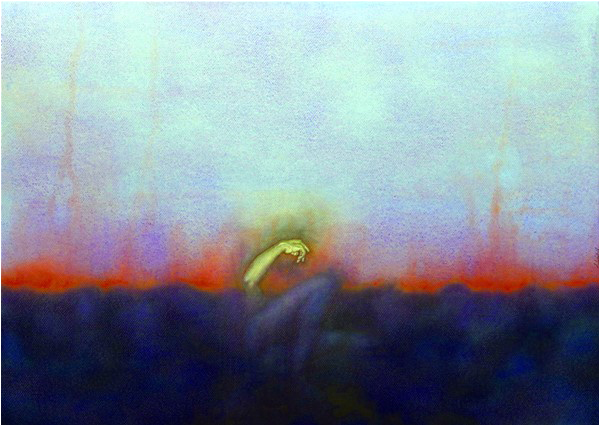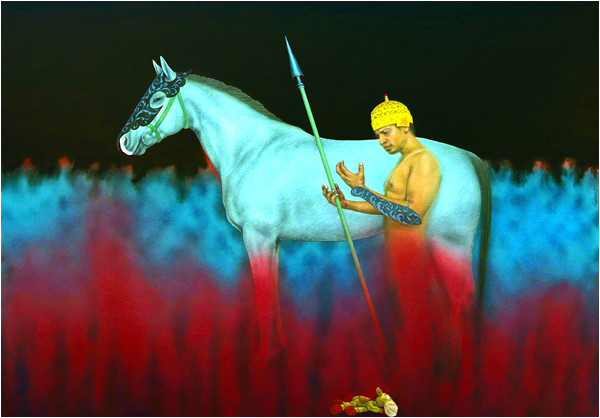
Persian poet Ferdowsi spent 30 years on the Shahnama. Its 60,000 verses are part history book, part fairy tale, with trees blossoming through its sentences and demons and serpents accosting warriors. Britain and Russia fought over its stunning pages. But Mahmud of Ghazni, the sultan to whom Ferdowsi first presented it, was unimpressed. Ferdowsi died a broken man. His Shahnama however, soared across oceans and time, like its mythical Simurgh, acquiring a life of its own, inspiring paintbrushes and pens from Victorian poet Mathew Arnold, to the Taliban’s semi-literate mind.
“Shahnama, A journey towards the Self” is artist Mudassar Manzoor’s solo show at Karachi’s Chawkandi art gallery, displaying 18 melancholy responses to the epic. The opening also featured the artist in conversation with art critic Nusrat Khwaja, where Manzoor spoke in detail about the Self. With painting titles like “Love is the sea where intellect drowns” or “Remembering the deep root of our Being”, Manzoor’s is a preoccupied, verbose mind that freely quotes Rumi and Einstein.

When we chat afterwards, he asks if I’m following his train of thought—a zip through Hadith, Einstein and etymologies—I confess I was lost. The train is fast and the destinations intense. Thankfully his art has more pauses and what he calls ‘silences’. And this is where he really shines. Precise glorious warriors from an ancient epic are smudged. It’s like we are seeing them from a fuzzy television set. The results are mysteriously beautiful. Works like “Past, present, future…Its all One” and the diptych “Concealed in the magnificent play of the Self”, have a haunting ache. There’s a wonderful play of the intricacy of a miniature, the charcoal smoke of a drawing, and the textural mystery reminiscent of Meher Afroz.
Some of the works are heavily laden and jewel-like. Manzoor said he was inspired by Rothko, and the paintings have strong simple blocks of space and suggestions of locations. You can see the influence of R.M. Naeem, in whose studio he’s worked, with the defined figures in empty geometric spaces.

Manzoor’s last Karachi show, ‘I washed the dust of the eyes with blood’ was more violent and troubling. Now there’s a sense of calm: Manzoor is absorbed with the silence of the mind, the stillness of peace. He says he wants to portray “an undistracted mind”. In a work titled “A melody of your own stillness” his lines float like a head of hair submerged in water. Comfortable in his medium, he’s spent 13 years using the same tools and developed a distinctive technique of curtains of watercolour and pigment.
Charles Melville, Professor of Persian Studies at the Faculty of Asian and Middle Eastern Studies, University of Cambridge, called the Shahnama a “political statement” and “a tirade against tyranny.” For a 2010 show marking 1,000 years of the Shahnama, Manzoor painted “Confrontation II”, where his Rustam is replaced by an American soldier, complete with battle gear—sunglasses, headgear and machinery—standing in a blazing space with Persian patterns. The artist uses the book’s motifs to comment on our pushy approach to religion, “Mera sach tumharay sach sey zyada sach hai” (my truth is more truth than yours); where respect for other viewpoints is rare, and our funerals and gatherings are centres of disagreement. And it’s not surprising that the Shahnama would fit perfectly into this, because at the heart of the epic is the struggle between good and evil, between the divine and the devil. And Manzoor keeps returning to this moment, this confrontation. But it looks silent and eerie.
A dark grid protrudes from one side in “Who is protecting Whom”, evoking the Holy Ka’abah. The mythical Simurgh’s protective feather dangles over it while a warrior looks on – it speaks volumes about the dynamics of power among today’s nations. In “Remembering the Deep root of our being”, a lifeless figure lies sprawled, in Manzoor’s dreamy mist. The Simurgh’s feather is untouched by this fog, its detailed fins stark and defiant.
Part of the poem’s appeal is that it’s so pliable, even capturing the Taliban’s imagination. In “Painting the Persian book of Kings today”, writer Suroosh Irfani describes the “Inversion of Rostam’s meaning—from an upholder to destroyer of human life and values—a motif of miniature artist Khadim Ali in his Rostam series ever since he witnessed the Taliban’s embrace of Rostam. Taliban fighters known for their hositility to Iran and Persian culture, were identifying themselves with Rostam as a role model.”

As Manzoor, tells me at the opening, Rumi wrote “in another time, in another tongue” but he’s still being discussed in new languages and time zones. As you wander through the Karachi show on a warm March evening, it’s funny that Ferdwosi predicted we would still discuss him:
“I shall not die, these seeds I’ve sown will save
my name and reputation from the grave
And men of sense and wisdom will proclaim
When I have gone, my praises and my fame.”
“Shahnama, A journey towards the Self” is artist Mudassar Manzoor’s solo show at Karachi’s Chawkandi art gallery, displaying 18 melancholy responses to the epic. The opening also featured the artist in conversation with art critic Nusrat Khwaja, where Manzoor spoke in detail about the Self. With painting titles like “Love is the sea where intellect drowns” or “Remembering the deep root of our Being”, Manzoor’s is a preoccupied, verbose mind that freely quotes Rumi and Einstein.

When we chat afterwards, he asks if I’m following his train of thought—a zip through Hadith, Einstein and etymologies—I confess I was lost. The train is fast and the destinations intense. Thankfully his art has more pauses and what he calls ‘silences’. And this is where he really shines. Precise glorious warriors from an ancient epic are smudged. It’s like we are seeing them from a fuzzy television set. The results are mysteriously beautiful. Works like “Past, present, future…Its all One” and the diptych “Concealed in the magnificent play of the Self”, have a haunting ache. There’s a wonderful play of the intricacy of a miniature, the charcoal smoke of a drawing, and the textural mystery reminiscent of Meher Afroz.
Some of the works are heavily laden and jewel-like. Manzoor said he was inspired by Rothko, and the paintings have strong simple blocks of space and suggestions of locations. You can see the influence of R.M. Naeem, in whose studio he’s worked, with the defined figures in empty geometric spaces.

Manzoor’s last Karachi show, ‘I washed the dust of the eyes with blood’ was more violent and troubling. Now there’s a sense of calm: Manzoor is absorbed with the silence of the mind, the stillness of peace. He says he wants to portray “an undistracted mind”. In a work titled “A melody of your own stillness” his lines float like a head of hair submerged in water. Comfortable in his medium, he’s spent 13 years using the same tools and developed a distinctive technique of curtains of watercolour and pigment.
Charles Melville, Professor of Persian Studies at the Faculty of Asian and Middle Eastern Studies, University of Cambridge, called the Shahnama a “political statement” and “a tirade against tyranny.” For a 2010 show marking 1,000 years of the Shahnama, Manzoor painted “Confrontation II”, where his Rustam is replaced by an American soldier, complete with battle gear—sunglasses, headgear and machinery—standing in a blazing space with Persian patterns. The artist uses the book’s motifs to comment on our pushy approach to religion, “Mera sach tumharay sach sey zyada sach hai” (my truth is more truth than yours); where respect for other viewpoints is rare, and our funerals and gatherings are centres of disagreement. And it’s not surprising that the Shahnama would fit perfectly into this, because at the heart of the epic is the struggle between good and evil, between the divine and the devil. And Manzoor keeps returning to this moment, this confrontation. But it looks silent and eerie.
At the heart of the Shahnama is the struggle between good and evil, between the divine and the devil. And Manzoor keeps returning to this moment, this confrontation. But it looks silent and eerie
A dark grid protrudes from one side in “Who is protecting Whom”, evoking the Holy Ka’abah. The mythical Simurgh’s protective feather dangles over it while a warrior looks on – it speaks volumes about the dynamics of power among today’s nations. In “Remembering the Deep root of our being”, a lifeless figure lies sprawled, in Manzoor’s dreamy mist. The Simurgh’s feather is untouched by this fog, its detailed fins stark and defiant.
Part of the poem’s appeal is that it’s so pliable, even capturing the Taliban’s imagination. In “Painting the Persian book of Kings today”, writer Suroosh Irfani describes the “Inversion of Rostam’s meaning—from an upholder to destroyer of human life and values—a motif of miniature artist Khadim Ali in his Rostam series ever since he witnessed the Taliban’s embrace of Rostam. Taliban fighters known for their hositility to Iran and Persian culture, were identifying themselves with Rostam as a role model.”

As Manzoor, tells me at the opening, Rumi wrote “in another time, in another tongue” but he’s still being discussed in new languages and time zones. As you wander through the Karachi show on a warm March evening, it’s funny that Ferdwosi predicted we would still discuss him:
“I shall not die, these seeds I’ve sown will save
my name and reputation from the grave
And men of sense and wisdom will proclaim
When I have gone, my praises and my fame.”

